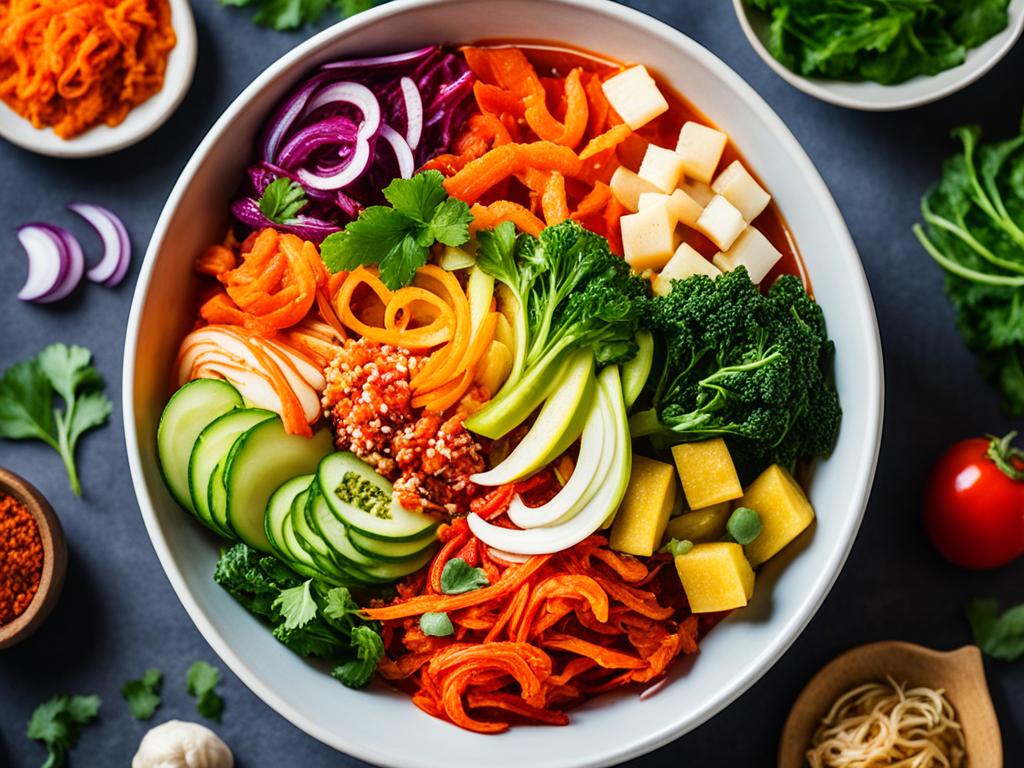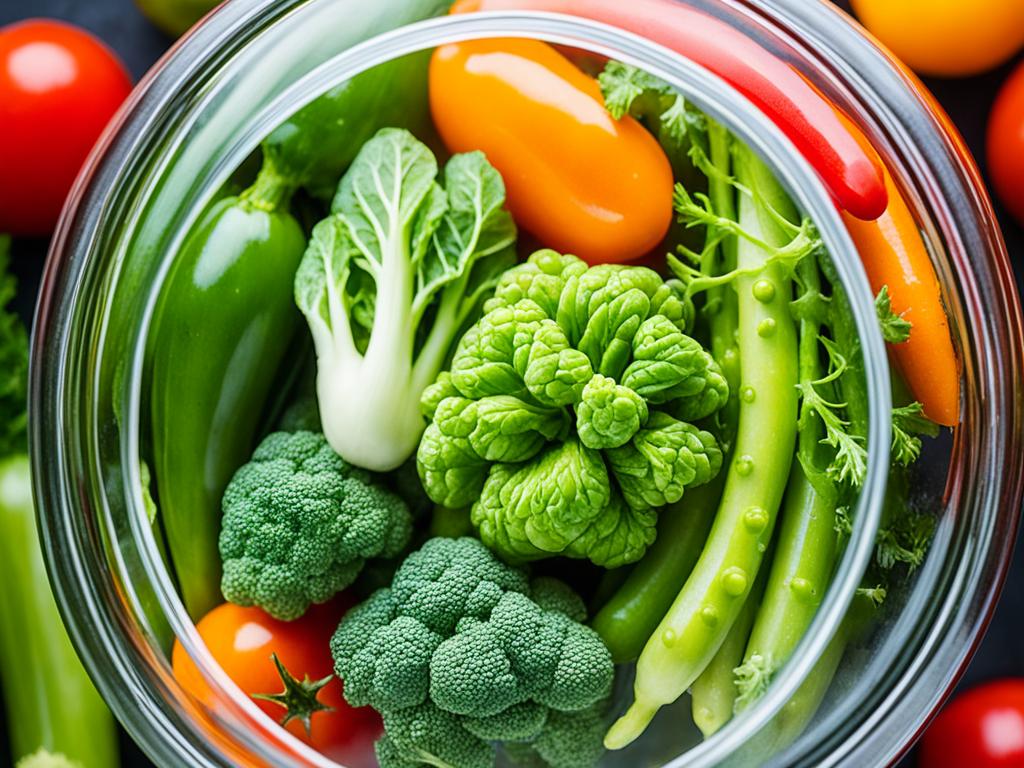Imagine sitting in a cozy Korean restaurant. The air is rich with the smell of kimchi. Your first taste of this dish bursts with lively flavors. It feels like you’re walking South Korea’s lively streets. Each bite offers a mix of tanginess, heat, and deep flavors. This cultural food is truly unique.
Kimchi is a well-loved Korean dish that many enjoy worldwide. It has been part of Korean meals for centuries. The process of making it, called fermentation, makes it more than just a food. Kimchi represents South Korea’s rich culture and Koreans’ love for their food heritage.South Korea is a country known for its vibrant culture, breathtaking landscapes, and of course, its delicious cuisine. When it comes to Korean food, there is one dish that stands out and has become incredibly popular in South Korea and beyond: kimchi. This traditional fermented vegetable dish has been a staple of Korean meals for centuries, and its unique flavors and health benefits have made it a favorite among food enthusiasts worldwide.
Kimchi is more than just a condiment or side dish; it is a representation of South Korea’s rich culture and a reflection of Koreans’ deep-rooted love for their food heritage. From the moment it is prepared, the process of making kimchi is a labor of love, involving a meticulous balance of ingredients and time-honored techniques. The result is a dish that is not only bursting with flavors but also packed with nutrients and probiotics known to be beneficial for gut health.
In South Korea, kimchi is so deeply ingrained in the daily lives of its people that it is not uncommon to find entire refrigerators dedicated solely to its storage. It is often enjoyed as a side dish alongside rice, soup, or even grilled meats. With endless variations and regional twists, there is no shortage of flavors and styles to choose from, making kimchi a truly versatile and exciting addition to any meal.
In this article, we will take you on a journey through the diverse flavors of kimchi, exploring the different types popular in South Korea and the various ways it can be incorporated into Korean cuisine. Whether you are a kimchi enthusiast or just starting to explore the wonders of Korean food, join us as we dive into the world of kimchi and discover why it has become an iconic symbol of South Korean culinary tradition.
This dish stands out not only for its flavors but also its health perks. It’s full of nutrients and probiotics, which help digestion and boost the immune system. It’s a powerhouse for keeping our stomachs and bodies healthy.
Let’s dive into kimchi’s story, its delicious tastes, and the good it does for us. We’ll explore how it’s made traditionally and why it’s now a hit all over the world. We’ll see why food lovers still can’t get enough of this Korean favorite.
Key Takeaways:
- Kimchi is a traditional Korean food known for its vibrant flavors and centuries-old tradition.
- The art of fermentation gives kimchi its distinct taste and enhances its health benefits.
- Kimchi offers numerous health benefits, including improved digestion and strengthened immune system.
- Kimchi has gained global popularity and has become a staple in many international cuisines.
- Exploring kimchi allows us to appreciate the rich cultural heritage of South Korea and its culinary traditions.
The History and Tradition of Kimchi in South Korea
Kimchi is a big part of South Korean culture. It has been loved in Korean homes for many years. This food shows the unique tastes and cooking ways of Korea. Now, let’s learn more about where kimchi comes from and why it’s so important.
The Origins of Kimchi
Kimchi goes way back to ancient times, during the Three Kingdoms period. People started fermenting vegetables to keep them through the winter. This helped when fresh food was hard to find. Over time, kimchi became the tasty and versatile dish we know now.
The Integral Role in Korean Cuisine
Kimchi is key in Korean meals. It’s often eaten with rice and other foods, making the meal spicy and sour. People also use it in many recipes, like pancakes or stews. Kimchi’s bright colors and bold flavors make it a great addition to any meal.
Cultural Significance and Celebratory Events
In South Korea, kimchi is more than food. It’s tied to family traditions and memories. Families and neighbors get together to make it before the cold season starts. This process, called kimjang, is a way for people to connect. Kimchi is essential during holidays like Lunar New Year and Chuseok. It’s seen as bringing luck and wealth.
Kimchi is a window into South Korea’s food and culture. It’s more than just a dish. It speaks to the traditions that have been handed down over time.
The Art of Fermentation: Creating the Perfect Kimchi
Kimchi stands out because of how it’s made – through fermentation. This process involves the natural breakdown of veggies. This is thanks to lactic acid bacteria. It gives kimchi its unique taste and crunch. Fermentation is a method for both preserving and making vegetables more nutritious and flavorful.
The choice of vegetables is key to making the best kimchi. While cabbage is the usual pick for kimchi, you can use other veggies like radishes, cucumbers, or scallions for a twist. All the veggies get salted and sit for a bit. This draws out extra water.
After the veggies lose some water, a special paste is made. It’s a mix of chili peppers, garlic, ginger, and more. This paste is what makes kimchi taste spicy and tangy. How much spice you add depends on what you like and where you’re from.
Then, the vegetable- paste mix goes into containers to ferment. Over time, the bacteria on the veggies turn the sugars into lactic acid. This makes the kimchi sour and helps it last longer. This fermentation is what makes kimchi taste so unique.
Some people like to eat their kimchi after just a few days of fermenting. This gives it a milder taste. Others prefer it after a few weeks, aiming for a strong, sour flavor.
In South Korea, different places have their own kimchi styles. For instance, the north enjoys kimchi that’s not too spicy. But the south likes it hot and bold. These differences make the world of kimchi in South Korea rich and varied.
The Many Variations of Kimchi
Kimchi comes in many flavors and styles, way beyond just one recipe. There are lots of kimchi types, each with different veggies, seasonings, and ways of fermenting. Here are a few well-known ones:
- Baechu Kimchi: This type features napa cabbage and is very traditional.
- Kkakdugi: Instead of cabbage, kkakdugi has cubes of radish. It’s crunchy and refreshing.
- Ggakdugi: This kind swaps radishes for cubed pickling cucumbers. It’s a bit different but just as tasty.
- Mulgimchi: Water kimchi is kimchi in a cucumber-based broth. It’s mild and cool, a nice change from the usual.
- Mak Kimchi: This is a lighter kimchi for the summer months. It’s great as a side dish when it’s hot out.
These variations show just how flexible and creative kimchi can be. Each type offers a unique eating experience.
Regional Variations of Kimchi in South Korea
| Region | Characteristics |
|---|---|
| Gyeonggi Province | Makes kimchi that’s mild and less spicy |
| Gyeongsang Province | Makes very spicy kimchi with a strong garlic kick |
| Jeolla Province | Mixes veggies and seafood in their kimchi |
| Gangwon Province | Focuses on light and radish-based kimchi for a refreshing taste |
The different kimchi styles across South Korea show a wide range of food traditions. They highlight the creativity and skill of local chefs and home cooks. They’re an essential part of South Korea’s food culture.
Health Benefits of Kimchi: A Probiotic-Rich Superfood
Kimchi is a favorite Korean dish that not only tastes great but is good for your health. It’s full of nutrients and helps with digestion, makes your immune system stronger, and keeps your gut health in check.
“Kimchi contains live bacteria cultures that aid in promoting a healthy balance of gut microbiota, which plays a crucial role in supporting our immune system and digestive health.” – Dr. Soohyun Jeon, a renowned nutritionist.
The way kimchi is made, through fermentation, boosts its health value. During this process, good bacteria called probiotics are formed. They help keep your gut healthy. Probiotics break down food and help your body absorb necessary nutrients.
Kimchi’s fermentation also produces lactic acid and other organic acids. These acids keep the gut slightly acidic. This helps stop bad bacteria from growing. Good bacteria thrive in this environment, which is great for your gut.
Kimchi is packed with essential vitamins and minerals. It’s loaded with vitamin C, vitamin K, and vitamin A. These keep your immune system strong, your skin healthy, and your eyesight sharp.
The Key Health Benefits of Kimchi:
- Enhances digestion and nutrient absorption
- Boosts the immune system
- Promotes a healthy gut microbiome
- Supports weight management
- Reduces inflammation
- May have anticancer properties
Studies show that kimchi is really good for you. A study in the Journal of Medicinal Food showed it can lower body fat and cholesterol in obese people. It also helps with blood sugar levels.
Another study in the Journal of Nutrition and Cancer found kimchi may reduce the risk of stomach and colorectal cancers. This is because of the antioxidants and phytochemicals in kimchi.
The best way to benefit from kimchi is to eat it often. Use it as a side dish or add it to soups for a tasty, healthy meal. Kimchi adds a kick of flavor and nutrition to your food.
Adding kimchi to your diet means enjoying the flavors of South Korea. It also means getting the health advantages of this top-notch probiotic food.

| Health Benefits of Kimchi: | Scientific Studies |
|---|---|
| Enhances digestion and nutrient absorption | A study published in the Journal of Medicinal Food found that regular kimchi consumption was associated with improved digestion and nutrient absorption. |
| Boosts the immune system | Research conducted at Yonsei University in South Korea demonstrated that kimchi consumption strengthens the immune system, promoting overall health and well-being. |
| Promotes a healthy gut microbiome | A study published in the Journal of Agricultural and Food Chemistry revealed that kimchi contains beneficial bacteria that support a healthy gut microbiome. |
| Supports weight management | Studies have shown that kimchi consumption may help manage body weight by promoting feelings of fullness and reducing calorie intake. |
| Reduces inflammation | Research suggests that the antioxidants and phytochemicals present in kimchi can help reduce inflammation in the body, contributing to better overall health. |
| May have anticancer properties | A study published in the Journal of Nutrition and Cancer found that kimchi contains compounds that may have protective effects against certain types of cancer. |
Kimchi’s Popularity: From South Korea to the World
In recent years, kimchi has become a global favorite, not just in South Korea. It is a well-loved dish around the world. The flavors and cultural value of this Korean food have won over many food lovers globally.
Kimchi’s journey to international fame has a few reasons behind it. South Korea’s entertainment scene has made its culture more exciting to people. This growing interest also sparked more curiosity about Korean food.
But it’s not just the entertainment scene that drew people to kimchi. The dish’s health benefits also made it popular. Known for its nutrition, kimchi is great for the immune system and the gut. It’s packed with vitamins, minerals, and good bacteria.
Kimchi is a true example of how food can be both delicious and nutritious. Its unique combination of flavors and health benefits has made it a hit among health-conscious individuals worldwide.
Korean restaurants around the globe have started serving kimchi due to its growing demand. The dish is not just for traditional places but also in fusion cuisines. This move has made it more accessible to food lovers everywhere.
Many food enthusiasts and chefs have adopted kimchi in their recipes. They share these dishes online for others to try. With kimchi widely available in stores and online, it’s easy for anyone to cook with it.
The rise of kimchi has even interested big media like NPR’s The Salt. They explored how this dish connects South Korea to the world. This shows kimchi’s importance beyond just being a food.
Kimchi has truly gone from being a traditional food to a global food. Its amazing taste and health benefits have won the world over. With more people enjoying kimchi, it has become South Korea’s food ambassador. It’s a favorite on dining tables everywhere.
Conclusion
Kimchi shows the amazing flavors and tradition of South Korea. This Korean food is famous for its fermentation and healthy probiotics. It’s more than just food; it’s a symbol of Korean culture that the world loves.
Kimchi comes from South Korea and is a favorite there. It’s made by fermenting veggies, mostly cabbage. This shows how Korea keeps its dishes tasty and healthy.
Kimchi is not just delicious; it’s good for us too. It helps our gut and strengthens our immune system. The way it’s made keeps the veggies full of vitamins and minerals.
People everywhere love kimchi, whether it’s by itself or in other dishes. It’s now a hit all over the world. Even top chefs include kimchi in their menus. So, this Korean delight brings smiles to many faces globally.
FAQ
What is kimchi?
Kimchi is a spicy, flavorful Korean dish. It’s made from fermented veggies, mainly cabbage.
What is the significance of kimchi in Korean cuisine?
Kimchi is a key part of Korean meals. It’s a must-have side dish that makes every meal taste better.
What are the health benefits of kimchi?
This dish is great for your health. It helps with digestion and boosts your immune system. Plus, it’s packed with vitamins and minerals.
Is kimchi popular only in South Korea?
While started in South Korea, kimchi is loved worldwide. Food enthusiasts everywhere enjoy it. It’s found in many international restaurants too.
How is kimchi prepared?
Making kimchi involves seasoning veggies like cabbage with spices. These include chili pepper, garlic, and ginger. Then, it’s left to ferment.
Are there different variations of kimchi?
Yes, there are many kimchi types. Each South Korean region has its special recipe. Some kinds are radish, cucumber, and white kimchi.
Can kimchi be incorporated into different recipes?
Yes, kimchi is versatile. It can go in stir-fries, soups, or on burgers. Its flavors enhance a variety of food.
How long does kimchi last?
Kimchi lasts months in the fridge due to fermentation. It might taste even better as it ages, often called “ripe kimchi.”
This traditional Korean dish is made from spicy cabbage and other fermented vegetables. Not only is it delicious, but it’s also packed with beneficial bacteria, making it a probiotic-rich food.
The fermentation process creates a tangy and pungent flavor that intensifies over time. Freshly made kimchi has a crunchy texture and a bold taste, while older kimchi becomes softer and more sour. Some people even prefer the taste of kimchi that has been aged for several weeks or months.
Proper storage is important to maximize the shelf life of kimchi. When stored in an airtight container in the refrigerator, it can last for several months. However, its flavor will continue to change over time. So, if you enjoy the taste of ripe kimchi, consider allowing it to ferment for a longer period before consuming.
In summary, kimchi can last for months when stored correctly in the refrigerator. Its fermented nature allows for its preservation and also contributes to its unique flavor profile. So, why not give it a try and experience the deliciousness of this probiotic-rich, spicy cabbage dish?Kimchi, a staple of Korean cuisine and popular in South Korea, is a delicious and healthy addition to any meal. But how long does kimchi actually last? The answer lies in its fermentation process.
Due to its fermented nature, kimchi has the ability to be preserved for a long period of time. When stored properly, it can last for several months or even up to a year. However, the flavor and texture of kimchi will change as it ages.
In the early stages of fermentation, kimchi is crisp, tangy, and spicy. As time goes on, it starts to develop a more sour and pungent flavor. Some people prefer the older, more matured kimchi, while others enjoy it when it’s fresher. It all depends on personal preference.
To maximize the lifespan of your kimchi, it’s important to store it correctly. Keep it in a sealed container in the refrigerator to slow down the fermentation process. This will help maintain its flavors as well as prolong its shelf life. So, next time you indulge in South Korean cuisine, don’t hesitate to savor the unique taste of kimchi that only grows richer with time.When it comes to traditional Korean food, kimchi is undoubtedly one of the most iconic dishes in Korean cuisine. This fermented side dish, made with cabbage and a variety of spices, has been a staple in Korean households for centuries. But have you ever wondered how long kimchi can last?
The fermentation process is what gives kimchi its distinct flavor and texture. It not only enhances the taste but also acts as a natural preservative, allowing kimchi to last for a long period if stored properly. On average, kimchi can stay fresh for up to several months when stored in the refrigerator.
The duration of kimchi’s shelf life depends on several factors such as the ingredients used, the fermentation process, and the storage conditions. Traditional kimchi, which is typically made with Napa cabbage, daikon radish, and various seasonings, tends to have a longer shelf life compared to variations that contain additional ingredients like seafood or fruit.
To ensure the longevity of your kimchi, it is essential to store it in an airtight container and keep it refrigerated. As time goes by, the taste of kimchi may change, becoming more sour and complex. Many Koreans actually prefer older kimchi for its deeper and tangier flavors. So, next time you indulge in South Korean cuisine, don’t hesitate to savor the unique taste of kimchi that only grows richer with time.Kimchi is a traditional Korean food that has become increasingly popular worldwide. This fermented vegetable dish is a staple in Korean cuisine and is known for its spicy and tangy flavors. But, if you find yourself with a surplus of kimchi or wondering how long it will last, fret not. Kimchi has a lengthy shelf life, allowing you to enjoy it over an extended period.
The fermentation process of kimchi helps preserve the vegetables and enhance its flavors. When stored properly in the refrigerator, kimchi can last for several months to even a year. The taste and texture of kimchi evolve over time, with the flavors deepening and becoming more pungent. Some people even prefer older kimchi for its unique and robust taste.
In South Korea, kimchi is often prepared in large quantities during the fall season when Napa cabbage, the main ingredient, is at its peak freshness. Families and communities come together to prepare kimchi, storing it in big jars to last them throughout the year. This age-old tradition speaks to the significance of kimchi in South Korean culture and its importance as a beloved culinary delight.
So, if you’re a fan of Korean cuisine, don’t hesitate to relish the flavorful taste of kimchi. Whether you enjoy it fresh or prefer to let it mature, this traditional dish is a delightful addition to any meal and will continue to bring its distinctive flavors to your taste buds for months to come.




